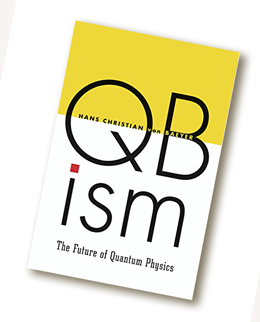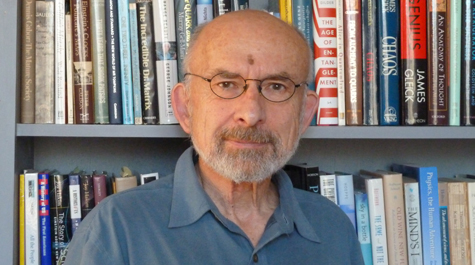Does Quantum Bayesianism hold the keys to the future of physics? Hans von Baeyer believes so.
Hans von Baeyer will give a presentation based on his book, followed by a book signing. The lecture, titled The Friendly Quantum, will be at 5:30 p.m. Jan. 27 in 111 Small Hall. - Ed.
QBism is pronounced “cubism,” but it’s short for Quantum Bayesianism, so don’t start thinking about Picasso. QBism, Hans von Baeyer explains, is an approach to understanding quantum mechanics. Pioneered by Max Planck and refined by Albert Einstein, quantum mechanics became an essential tool for theorists and experimenters — and gave us many practical everyday developments, such as the laser, the computer and the cell phone. Quantum mechanics worked, but physicists couldn’t explain why it worked.
Hans von Baeyer is Chancellor Professor of Physics, Emeritus, at William & Mary. In his 2016 book, QBism: The Future of Quantum Physics, von Baeyer explains how scientist/mathematicians used the probability theory of an 18th century Presbyterian minister to understand the workings of quantum mechanics. Patient, thoughtful lay readers should have no trouble with the book. But expect an intellectual reset: You’ll get an “everything I learned is wrong” feeling a couple times, but keep your mind open, and you’ll be rewarded of a greater understanding of how the universe operates.
 Who is the audience for this book?
Who is the audience for this book?
I wrote the book for anyone who has heard the word “quantum” but has no idea what the phrases “quantum physics”, “quantum mechanics” and “quantum theory” (which I treat as synonymous) are all about. In other words, my book is for lay readers. Perhaps my most hoped-for audience consists of physics students from high school to Ph.D.: I want them to become aware of a new interpretation that is not yet in their textbooks. But in the past I have also received many questions and comments from readers who had no truck with physics in their professions (scientists, lawyers, doctors, engineers, artists, teachers, clergy…), who understand and respect the role of science in our lives, and who enjoy thinking about physics.
What is the penetration level of QBism among physicists?
QBism is the newest and therefore least well-known of about a dozen different interpretations of quantum mechanics, each with countless distinct variants. All of them agree on the fundamental equations — the formalism— and the astonishing practical successes of the theory, but disagree about its meaning. Since the birth of QBism around the turn of this century, many physicists have come across the term, few have studied it, and fewer prefer it to the older interpretations. But those numbers are growing rapidly. By now, there is a useful entry in Wikipedia, and in December 2016 an excellent article on QBism appeared in the authoritative online Stanford Encyclopedia of Philosophy – tokens of entry into the canon. Hundreds of articles and conference proceedings deal with QBism. As far as I know, mine is the first popular book on the subject, and textbooks have yet to be written. Stay tuned!
Is there anything else “out there” that might replace QBism as a toolbox for quantum mechanics?
It’s really the other way around! There are many “standard” interpretations of quantum mechanics, and a few non-standard ones, that are taught in school. In my book, an appendix briefly mentions four of the most popular. QBism would like to preplace THEM. The toolbox is the mathematical formalism of quantum mechanics, which everyone agrees on, and which doesn’t need replacement. Let me illustrate the difference between a formalism and its meaning with an analogy. Imagine a drug that cures a certain disease with admirable consistency and reliability. Doctors, patients, and medical researchers all agree on its efficacy. It is a valued instrument in the “toolbox” of medicine. But the researchers are hopelessly deadlocked over its function. One camp is convinced that it works through the nervous system, while the other insists that it is carried by the blood. To date, nobody has figured out how to answer the question by experiment. Controversy persists. The value of trying to figure out the fundamental meaning of any phenomenon does not derive from its current usefulness, but from the future rewards enhanced understanding will surely bring.
A way to avoid debates about the nebulous word meaning is to ask instead: What exactly is the wonderful thing about nature that the unquestioned success of quantum mechanics is trying to tell us? QBism furnishes clues that makes sense to me.
You write of the “physicists’ suspicion, verging on disdain, of philosophy,” which seems to be dissolving somewhat. What is the proper relationship of physics and philosophy?
In his 1992 book Dreams of a Final Theory, in a chapter entitled Against Philosophy, the eminent Noble laureate Steven Weinberg wrote: “The insights of philosophers have occasionally benefited physicists, but generally in a negative fashion – by protecting them from the preconceptions of other philosophers” (page 166). What he advocated instead was to start with the standard formalism, to add new bits and pieces to it, and then to test the predictions of the altered version of quantum mechanics against experimental evidence. This is good, conservative scientific procedure, and avoids philosophy. But unlike QBism it is not radical: It does not try to dig down to the root (radix in Latin) of the controversy about meaning. Instead, it adds speculative superstructure which it then seeks to confirm or rule out experimentally.
Today, 25 years later, Weinberg reiterates his suggestion. In The New York Review of Books dated 1/19/17 he begins an article entitled “The Trouble with Quantum Mechanics” with the words “…despite the great successes of quantum mechanics, arguments continue about its meaning, and its future.” The bells and whistles he would add to the theory have changed in the intervening decades, but philosophy is again shunted aside. This time Weinberg divides the interpretations of quantum mechanics into two groups labeled realist and instrumentalist. By dismissing both, he sells QBism short, and therefore avoids the need to mention it. The above-mentioned article by Richard Healy in the Stanford Encyclopedia of Philosophy states: "Instrumentalism is usually contrasted with realism as a view of science ... QBism offers a more nuanced view, both of quantum theory as a theory and of science in general ... [QBism’s principal spokesman Christopher] Fuchs thinks one thing quantum theory has taught us about the world is that it is much richer than we may have thought ... "
My point is that in addition to closing off speculations by philosophers, philosophy can open up the minds of physicists to fruitful new avenues of inquiry they had not imagined before. QBism is a case in point.
When Rev. Bayes comes into the narrative, I get this full-circle feeling. “Bayesian probability is a measure of an agent’s personal degree of belief that an event will occur or that a proposition is true” reads to me like an endorsement and vindication of plain old “luck?”
Degrees of belief that an event will occur matter because they result in action. If I believe that the probability of rain this afternoon is 90 percent, I’ll take my umbrella. If I believe it is 5 percent, I won’t. But my beliefs are not simply wild guesses. They are not mere appeals to luck. They are backed up by huge, expensive, highly sophisticated scientific projects called meteorological computer programs. They are rationally arrived at, but they are beliefs, nevertheless. They matter because they have consequences. A more significant example was Obama’s belief that chances for the success of the bin Laden mission were above 50 percent.
Should Bayesian concepts replace frequentist probability in other aspects of science, such as the standard deviation and p-values?
One of the great advantages of subjective Bayesian probability is that it can effortlessly incorporate frequentist results, but not the other way around. The reason is that frequentist probability furnishes a method for determining probabilities, but Bayesian probability furnishes the meaning for the numbers so determined. It’s a bit like determining the volume of a bucket by filling it with water, and dividing its weight by the density of water in pounds per cubic inch. The meaning of the volume is geometrical, regardless of the way it was determined.
Your book is full of snippets such as “quantum randomness violates the law of cause and effect” and “the trouble with time is that it doesn’t exist.” We are told that electrons don’t act as we thought they did according to our beloved Bohr atom “caricature,” and that quantum mechanics has trumped common sense. You note that Samuel Johnson replied to similar notions by kicking a large stone and saying, “I refute it thus!” How can you persuade someone who stands with a sore toe beside Dr. Johnson?
Rocks and sore toes belong to our Newtonian, human world. Why should its categories and its rules apply to inaccessible realms, like the cosmic or the atomic worlds? By the categories of 18th century European biologists, platypuses were impossible – yet they existed. By Newton’s rules, the duration of a second is unaffected by the speed or the gravitational environment of the clock that measures it, yet every GPS in the world proves otherwise. To prove that common sense is an unreliable guide to how the world is made, google “Cafe Wall Illusion.”
 Skip to main content
Skip to main content

